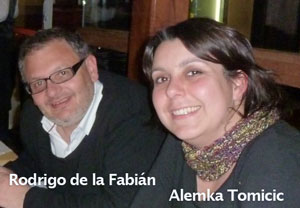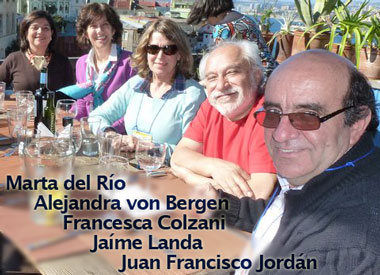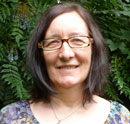 |
The International Association for Relational Psychoanalysis and Psychotherapy |
|
|
|
Speaking of the 12th
Chilean Congress of Psychotherapy
and looking forward to the
IARPP Conference in November 2013
By Mary Lynne Ellis, UK
In his poem La Palabra (The Word, 1962), the Chilean poet, Pablo Neruda, writes, “And, for human beings, not to speak is to die” (“Y no hablar es morir entre los seres”). My experience of visiting Chile in August this year was one of discovering a vibrant culture in which language truly breathes – in poetry, dancing, music, singing, composing, visual arts, including architecture, street art, and textiles, in film, and in theatre, in people’s voices, in their stories, in their humour, and in their faces. The capacity of Chilean people to speak in a plurality of ways not only survived the years of the military dictatorship but created the conditions for its end. This capacity has also generated the development of imaginative practices and research in psychotherapy contemporaneously in Chile. Within a few days of the CIA backed military coup in 1973 the military had tortured and killed the musician, theatre director, and political activist, Victor Jara. Pinochet and his regime censored his songs and the artistic works of others who were viewed as a threat to the regime. They burned books (including Neruda’s library) and drove many creative artists into exile. Singing, writing, filming, and visual art practices (created largely in secret or in captivity) sustained those who remained as they, their relatives and their friends, “disappeared”, were tortured, imprisoned, or killed; these different ways of speaking kept the voices of resistance alive. The voices of those in exile also spoke through music and other media to the rest of the world about the trauma of the Chilean people. The support that they gathered was vital to those left in Chile whose creative campaigns finally brought an end to the regime seventeen years later.
Donna Orange from the US and I (from Britain) were invited as keynote speakers to a beautifully conceived conference, “The Other; That Great Diversity", the 12th Chilean Congress of Psychotherapy, at Reñaca. The President of the Congress, Claudio Martínez Guzmán, a psychotherapist and professor of psychology at Diego Portales University and also an IARPP member, invited Pablo Simonetti, the Chilean novelist and gay activist to open the conference. Simonetti spoke of his life as a gay man in Chile. I do not speak Spanish but I knew from his face and his voice and the atmosphere in the audience how moving, how personal, and how directly engaging his story was. He emphasised the importance of psychotherapists taking up the responsibility of challenging pathologising theories of homosexuality.
In the evenings a wonderful programme of events was organised; it offered the opportunity for therapists to rehearse and perform - in a choir, in a folk band who movingly sang many of Victor Jara’s and Violeta Parrra’s songs, and in dance groups (flamenco and cueca, a Chilean national dance). A lively karaoke session took place on another night, and on the last night there was an exuberant fancy dress party with the most imaginatively conceived costumes expressing individuals’ “Side B.” The Congress impressed me deeply as an event which facilitated so many ways of speaking. An enormous diversity of interests and positions were articulated and readily engaged with in public and private conversations. There was a lived recognition of how critical it is that psychotherapists are connected to creative aspects of their lives – for themselves and for their clinical work. I experienced the therapists whom I met as being highly attuned to others’ vulnerability. Traditional dualisms of “inner” and “outer” worlds are being challenged by Chilean analysts influenced by phenomenology and intersubjective theories, (de la Fabian, 2002, del Rio, 2011, Jordan Moore, 2005, Olivos, 2003). Responding to the traumatic effects of the dictatorship requires a sensitivity to the specificity of individuals’ conscious and unconscious experiences that does not assume that these have their source primarily in, for example, a “inner world” of early infantile dynamics. In their original research Claudio Martínez Guzmán and Alemka Tomicic (both IARPP members) both argue that attention to this specificity requires us, vitally, to extend our attention to our patients’ speech to the subtle nuances of tones of the voice in the conversation between therapist and patient (Martínez Guzmán and Tomicic, 2011).
References Del Rio, M. (2011). Proceso terapéutico y supervisión. In: Psiquiatria Universitaria, Vol. 7, No. 1. Santiago, Chile: Departmento de Psiquiatria Oriente, Facultdad de Medicina, Universidad de Chile, pp. 77 – 84. Jordan Moore, J.F. (2005). External reality/internal reality: a real dichotomy? In (eds.) S. Lewkowicz and S. Flechner,Truth, Reality and the Psychoanalyst: Latin American Contributions to Psychoanalysis. IPA. Neruda, P.(2010). La Palabra. In (ed. M. Eisner), The Essential Neruda.Tarset, UK: Bloodaxe Books. Martínez Guzmán, C. (2011). Regulación mutua y Dialogicidad en Psícoterapia.
|

.jpg) The verbal and visual languages of Chile generate highly textured fields of articulation. These are woven from multiple voices transmitted across generations of indigenous peoples, of whom there are at least nine surviving groups, and of Europeans, including colonizers, immigrants, and refugees. In a new cultural centre located symbolically at La Moneda, the palace where socialist President Allende was killed on the day of the coup, I saw stunning pre-Columbian ceramics, weaving, jewellery, and ritual objects produced in diverse religious, political, philosophical, and symbolic contexts dating back 15,000 years. As I walked in the streets of Santiago I noticed how some of those images and symbols reappear in contemporary arts, including street art, alongside European colonial buildings and Catholic churches. These differences produce tensions, are enriching, and incite important questions with regard to discrimination and who is vested with the power to speak and in which contexts. A permanent display in La Moneda shows Violeta Parra’s (1917 - 1967) moving and imaginative collages, paintings, embroideries, and sound poems which are intensely personal and intensely political. Her work, along with Victor Jara and others has continued to inspire many in the Chilean Left. Murals, political posters and graffiti urge people to join in the crucial challenge to dissolve social inequalities.
The verbal and visual languages of Chile generate highly textured fields of articulation. These are woven from multiple voices transmitted across generations of indigenous peoples, of whom there are at least nine surviving groups, and of Europeans, including colonizers, immigrants, and refugees. In a new cultural centre located symbolically at La Moneda, the palace where socialist President Allende was killed on the day of the coup, I saw stunning pre-Columbian ceramics, weaving, jewellery, and ritual objects produced in diverse religious, political, philosophical, and symbolic contexts dating back 15,000 years. As I walked in the streets of Santiago I noticed how some of those images and symbols reappear in contemporary arts, including street art, alongside European colonial buildings and Catholic churches. These differences produce tensions, are enriching, and incite important questions with regard to discrimination and who is vested with the power to speak and in which contexts. A permanent display in La Moneda shows Violeta Parra’s (1917 - 1967) moving and imaginative collages, paintings, embroideries, and sound poems which are intensely personal and intensely political. Her work, along with Victor Jara and others has continued to inspire many in the Chilean Left. Murals, political posters and graffiti urge people to join in the crucial challenge to dissolve social inequalities. The rich range of themes presented by Chilean psychotherapists both as talks, workshops, and posters, included transsexuality, spirituality, couple relationships, social exclusion, psychosis, mindfulness, lesbian and gay identities, psychotherapy and the body, the migrant subject, divorce and mourning, men in therapy, biodanza, crisis intervention, addiction. Participants included analytical (relational, phenomenological, Winnicottian, Lacanian), Gestalt, and expressive arts therapists as well as family and couples therapists, including systems theorists. These sessions were, appropriately for the practitioners, in Spanish only. I very much appreciated the opportunity to share in a public dialogue (through simultaneous translation) with psychoanalyst/philosopher, Rodrigo de la Fabian, professor of psychology, Diego Portales University, Santiago, which we entitled The Politics of Listening. I was also extremely touched by the generosity of the many speakers/participants who joined me for extended informal discussions in English about psychoanalysis, philosophy, intersubjectivity, art therapy, and many other themes throughout the duration of the Congress.
The rich range of themes presented by Chilean psychotherapists both as talks, workshops, and posters, included transsexuality, spirituality, couple relationships, social exclusion, psychosis, mindfulness, lesbian and gay identities, psychotherapy and the body, the migrant subject, divorce and mourning, men in therapy, biodanza, crisis intervention, addiction. Participants included analytical (relational, phenomenological, Winnicottian, Lacanian), Gestalt, and expressive arts therapists as well as family and couples therapists, including systems theorists. These sessions were, appropriately for the practitioners, in Spanish only. I very much appreciated the opportunity to share in a public dialogue (through simultaneous translation) with psychoanalyst/philosopher, Rodrigo de la Fabian, professor of psychology, Diego Portales University, Santiago, which we entitled The Politics of Listening. I was also extremely touched by the generosity of the many speakers/participants who joined me for extended informal discussions in English about psychoanalysis, philosophy, intersubjectivity, art therapy, and many other themes throughout the duration of the Congress.  I am already excited at the prospect of returning to Santiago for the (bilingual) IARPP conference in summer November 2013, which is being organised by Juan Francisco Jordán Moore, MD., Chair of the Chilean Chapter, and María Eugenia Boetsch Salas. My experience of Chile has enhanced my life clinically, intellectually, and creatively in ways I could never have anticipated.
I am already excited at the prospect of returning to Santiago for the (bilingual) IARPP conference in summer November 2013, which is being organised by Juan Francisco Jordán Moore, MD., Chair of the Chilean Chapter, and María Eugenia Boetsch Salas. My experience of Chile has enhanced my life clinically, intellectually, and creatively in ways I could never have anticipated. Mary Lynne Ellis (B.A. Art, Dip. Art Th., M.A. Art Th., Dip. Psychoanalytic Psychotherapy (UKCP), M.A. Modern European Philosophy) has worked as an analyst in private practice for over 25 years in North London.
Mary Lynne Ellis (B.A. Art, Dip. Art Th., M.A. Art Th., Dip. Psychoanalytic Psychotherapy (UKCP), M.A. Modern European Philosophy) has worked as an analyst in private practice for over 25 years in North London.